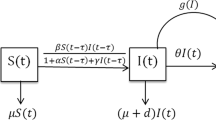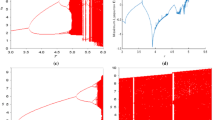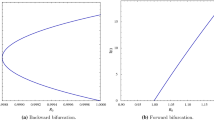Abstract
Investigation of the spatio-temporal patterns exhibited by infected communities sharing the same spatial region is the focus of many researchers. Typically, an individual’s susceptibility is substantially connected with the distance from nearby affected persons. Such a disease propagation mechanism is called the nonlocal infection which is primarily modeled with a kernel function K, whose support determines the range of the nonlocal infection area. In our current study, a susceptible–infected–susceptible-type epidemic model is analyzed considering the nonlinear disease incidence rate which is further extended to incorporate the nonlocal disease transmission and random movement of the individuals. Complete bifurcation characteristics of the associated temporal model include the saddle-node, subcritical Hopf, and homoclinic bifurcations. Our primary emphasis is to investigate the formation of a wide variety of spatio-temporal patterns that include stationary, quasi-periodic, periodic, and chaotic patterns, among others. Comparisons have been made between the spatio-temporal dynamics of the local and nonlocal disease transmission models. It is observed that the nonlocal disease transmission expands the parametric domain (referred to as Hopf and stable domains) on which the system possesses oscillatory and spatially homogeneous solutions. As a result, the spatially heterogeneous stationary solutions (referred to as Turing patterns) of the local system turn into irregular oscillatory solutions or spatially homogeneous solutions whenever the nonlocal extent of the disease transmission gradually increases. Also, the increased range of nonlocal infections reduces the number of stationary patches. In addition, the system exhibits “long transient” dynamics when the dispersal rate of the population tends to the Turing threshold. Exhaustive numerical simulations have been carried out to illustrate the wide range of spatio-temporal patterns displayed by the system in the presence and absence of nonlocal terms.
















Similar content being viewed by others
Data availability
Data sharing is not applicable to this article as no datasets were generated or analyzed during the current study. However, the codes or algorithms used in the simulation will be made available on specific requests.
References
Kermack, W.O., McKendrick, A.G.: A contribution to the mathematical theory of epidemics. Proc. Roy. Soc. Lond. Ser. A Contain. Pap. Math. Phys. Charact. 115(772), 700–721 (1927)
Ghosh, S., Volpert, V., Banerjee, M.: An epidemic model with time-distributed recovery and death rates. Bull. Math. Biol. 84(8), 78 (2022)
Das, D.K., Kar, T.: Global dynamics of a tuberculosis model with sensitivity of the smear microscopy. Chaos Solitons Fractals 146, 110879 (2021)
d’Onofrio, A.: A note on the global behaviour of the network-based sis epidemic model. Nonlinear Anal. Real World Appl. 9(4), 1567–1572 (2008)
Keeling, M.J., Rohani, P.: Modeling Infectious Diseases in Humans and Animals. Princeton University Press (2008)
Wang, Z., Bauch, C.T., Bhattacharyya, S., d’Onofrio, A., Manfredi, P., Perc, M., Perra, N., Salathé, M., Zhao, D.: Statistical physics of vaccination. Phys. Rep. 664, 1–113 (2016)
Li, H.-J., Xu, W., Song, S., Wang, W.-X., Perc, M.: The dynamics of epidemic spreading on signed networks. Chaos Solitons Fractals 151, 111294 (2021)
d’Onofrio, A., Manfredi, P.: Behavioral sir models with incidence-based social-distancing. Chaos Solitons Fractals 159, 112072 (2022)
Jana, S., Nandi, S.K., Kar, T.: Complex dynamics of an sir epidemic model with saturated incidence rate and treatment. Acta. Biotheor. 64(1), 65–84 (2016)
Van den Driessche, P., Watmough, J.: Reproduction numbers and sub-threshold endemic equilibria for compartmental models of disease transmission. Math. Biosci. 180(1–2), 29–48 (2002)
Ruan, S., Wang, W.: Dynamical behavior of an epidemic model with a nonlinear incidence rate. J. Differ. Equ. 188(1), 135–163 (2003)
Banerjee, M., Volpert, V.: Spatio-temporal pattern formation in Rosenzweig–Macarthur model: effect of nonlocal interactions. Ecol. Complex. 30, 2–10 (2017)
Malchow, H., Hilker, F.M., Siekmann, I., Petrovskii, S.V., Medvinsky, A.B.: Mathematical models of pattern formation in planktonic predation–diffusion systems: a review. Aspects Math. Modell. 8, 1–26 (2008)
Dey, S., Banerjee, M., Ghorai, S.: Analytical detection of stationary turing pattern in a predator–prey system with generalist predator. Math. Modell. Nat. Phenom. 17, 33 (2022)
Paquin-Lefebvre, F., Nagata, W., Ward, M.J.: Pattern formation and oscillatory dynamics in a two-dimensional coupled bulk-surface reaction–diffusion system. SIAM J. Appl. Dyn. Syst. 18(3), 1334–1390 (2019)
Zhang, L., Liu, J., Banerjee, M.: Hopf and steady state bifurcation analysis in a ratio-dependent predator–prey model. Commun. Nonlinear Sci. Numer. Simul. 44, 52–73 (2017)
Murray, J.D.: Mathematical Biology II: Spatial Models and Biomedical Applications, vol. 3. Springer (2001)
Raffel, T.R., Martin, L.B., Rohr, J.R.: Parasites as predators: unifying natural enemy ecology. Trends Ecol. Evol. 23(11), 610–618 (2008)
Malchow, H., Petrovskii, S., Venturino, E.: Spatiotemporal Patterns in Ecology and Epidemiology: Theory, Models, and Simulation. Chapman and Hall/CRC (2008)
González, E., Villena, M.J.: On the spatial dynamics of vaccination: a spatial sirs-v model. Comput. Math. Appl. 80(5), 733–743 (2020)
Allen, L.J., Bolker, B.M., Lou, Y., Nevai, A.L.: Asymptotic profiles of the steady states for an sis epidemic reaction–diffusion model. Discrete Contin. Dyn. Syst. 21(1), 1 (2008)
Sun, G.-Q., Jusup, M., Jin, Z., Wang, Y., Wang, Z.: Pattern transitions in spatial epidemics: mechanisms and emergent properties. Phys. Life Rev. 19, 43–73 (2016)
Li, L.: Patch invasion in a spatial epidemic model. Appl. Math. Comput. 258, 342–349 (2015)
Zhang, G.-B., Li, Y., Feng, Z.: Exponential stability of traveling waves in a nonlocal dispersal epidemic model with delay. J. Comput. Appl. Math. 344, 47–72 (2018)
Tian, B., Yuan, R.: Traveling waves for a diffusive seir epidemic model with non-local reaction. Appl. Math. Model. 50, 432–449 (2017)
Maidana, N.A., Yang, H.M.: Spatial spreading of West Nile Virus described by traveling waves. J. Theor. Biol. 258(3), 403–417 (2009)
Adimy, M., Chekroun, A., Kazmierczak, B.: Traveling waves for reaction–diffusion PDE coupled to difference equation with nonlocal dispersal term and time delay. Math. Model. Nat. Phenom. 17, 17 (2022)
Liu, Z., Shen, Z., Wang, H., Jin, Z.: Analysis of a local diffusive sir model with seasonality and nonlocal incidence of infection. SIAM J. Appl. Math. 79(6), 2218–2241 (2019)
Liu, W.-M., Levin, S.A., Iwasa, Y.: Influence of nonlinear incidence rates upon the behavior of sirs epidemiological models. J. Math. Biol. 23(2), 187–204 (1986)
Liu, W.-M., Hethcote, H.W., Levin, S.A.: Dynamical behavior of epidemiological models with nonlinear incidence rates. J. Math. Biol. 25(4), 359–380 (1987)
Pal, S., Ghorai, S., Banerjee, M.: Analysis of a prey–predator model with non-local interaction in the prey population. Bull. Math. Biol. 80(4), 906–925 (2018)
Pal, S., Ghorai, S., Banerjee, M.: Effect of kernels on spatio-temporal patterns of a non-local prey–predator model. Math. Biosci. 310, 96–107 (2019)
Manna, K., Volpert, V., Banerjee, M.: Pattern formation in a three-species cyclic competition model. Bull. Math. Biol. 83(5), 1–35 (2021)
Banerjee, M., Volpert, V.: Prey-predator model with a nonlocal consumption of prey. Chaos Interdiscip. J. Nonlinear Sci. 26(8), 083120 (2016)
Manna, K., Volpert, V., Banerjee, M.: Dynamics of a diffusive two-prey-one-predator model with nonlocal intra-specific competition for both the prey species. Mathematics 8(1), 101 (2020)
Manna, K., Banerjee, M.: Spatiotemporal pattern formation in a prey–predator model with generalist predator. Math. Modell. Nat. Phenom. 17, 6 (2022)
Autry, E.A., Bayliss, A., Volpert, V.A.: Biological control with nonlocal interactions. Math. Biosci. 301, 129–146 (2018)
Wang, T.: Dynamics of an epidemic model with spatial diffusion. Physica A 409, 119–129 (2014)
Sun, G.-Q., Jin, Z., Liu, Q.-X., Li, L.: Chaos induced by breakup of waves in a spatial epidemic model with nonlinear incidence rate. J. Stat. Mech. Theory Exp. 2008(08), 08011 (2008)
Hastings, A., Higgins, K.: Persistence of transients in spatially structured ecological models. Science 263(5150), 1133–1136 (1994)
Hastings, A., Abbott, K.C., Cuddington, K., Francis, T., Gellner, G., Lai, Y.-C., Morozov, A., Petrovskii, S., Scranton, K., Zeeman, M.L.: Transient phenomena in ecology. Science 361(6406), 6412 (2018)
Morozov, A., Abbott, K., Cuddington, K., Francis, T., Gellner, G., Hastings, A., Lai, Y.-C., Petrovskii, S., Scranton, K., Zeeman, M.L.: Long transients in ecology: theory and applications. Phys. Life Rev. 32, 1–40 (2020)
Tao, Y., Hite, J.L., Lafferty, K.D., Earn, D.J., Bharti, N.: Transient disease dynamics across ecological scales. Thyroid Res. 14(4), 625–640 (2021)
Hethcote, H.W., van den Driessche, P.: Some epidemiological models with nonlinear incidence. J. Math. Biol. 29(3), 271–287 (1991)
Moghadas, S.M., Gumel, A.B.: Global stability of a two-stage epidemic model with generalized non-linear incidence. Math. Comput. Simul. 60(1–2), 107–118 (2002)
Bauch, C.T., Earn, D.J.: Transients and attractors in epidemics. Proc. Roy. Soc. Lond. Ser B Biol. Sci. 270(1524), 1573–1578 (2003)
Acknowledgements
The author Dhiraj Kumar Das gratefully acknowledges the financial support provided by the Science and Engineering Research Board, Government of India, through the National Postdoctoral Fellowship scheme under the file number PDF/2021/001915, dated January 4, 2022.
Author information
Authors and Affiliations
Corresponding author
Ethics declarations
Conflict of interest
The authors state here that they have no known competing financial interests or personal relationships that could have appeared to influence the work accounted for in this paper.
Additional information
Publisher's Note
Springer Nature remains neutral with regard to jurisdictional claims in published maps and institutional affiliations.
Rights and permissions
Springer Nature or its licensor (e.g. a society or other partner) holds exclusive rights to this article under a publishing agreement with the author(s) or other rightsholder(s); author self-archiving of the accepted manuscript version of this article is solely governed by the terms of such publishing agreement and applicable law.
About this article
Cite this article
Das, D.K., Ghorai, S. & Banerjee, M. Spatio-temporal dynamics of an SIS model with nonlinear incidence and nonlocal disease transmission. Nonlinear Dyn 111, 15591–15612 (2023). https://doi.org/10.1007/s11071-023-08633-1
Received:
Accepted:
Published:
Issue Date:
DOI: https://doi.org/10.1007/s11071-023-08633-1




